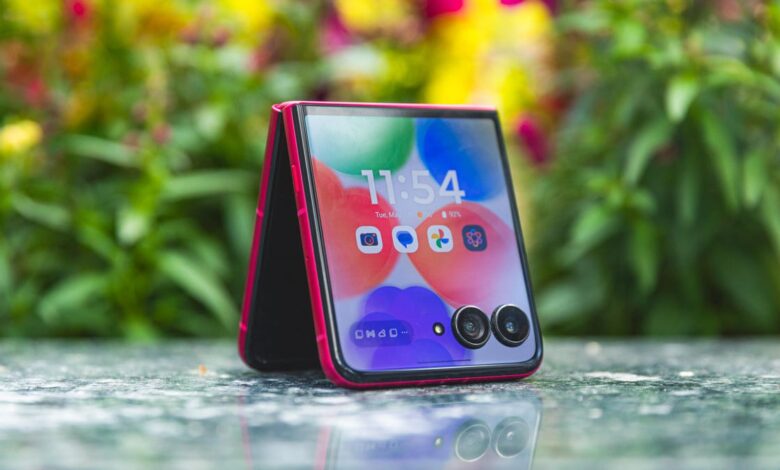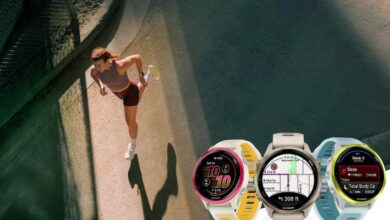I Tested the Motorola Razr Ultra. It’s Good, but Flipping Expensive

Pros
- Robust design
- Bright high resolution inner screen
- Battery life should last you a day or more
- It’s so damn fun to use
Cons
- Cameras take decent photos but suffer from motion blur
- Only three years of major OS updates
- Gets warm playing games and using the camera frequently
When I first started testing the Motorola Razr Ultra, I had flashbacks to my original Motorola Razr review. No, not the OG 2004 indestructible flip phone that Paris Hilton made fashionable. I’m talking about the first Motorola foldable phone, which came out in the early days of the pandemic. It had a $1,500 price tag, a screen that folded in half and plenty of nostalgia. But it lacked the He-Man-like specs of its competitor, the original Galaxy Z Flip. Some reviewers and Razr stans were bummed because the Moto foldable didn’t have the high-end specs and features that you’d normally expect for such a high price.
Motorola refined subsequent Razr models with better specs and found success by imbuing them with a fun and fashionable spirit while lowering the price and adding creature comforts such as all-day battery life. Fast forward to now, and the Razr Ultra has as few compromises as possible, with features including a Snapdragon 8 Elite chip and a titanium hinge. The Razr Ultra is an absolute unit, and it’s what we wanted back in 2020.
The Ultra is a beefed-up version of last year’s Razr Plus, which won a CNET Editor’s Choice Award. It’s as if the Razr Plus hired a trainer and nutritionist and then got absolutely ripped — warranting its name: Ultra. If you had doubts about a foldable phone’s durability, the Razr Ultra is here to prove you wrong. (Keep in mind that dust resistance is still an issue for all foldable phones, so I still wouldn’t take the Razr Ultra to the beach or on that salt factory tour you’ve been dying to do.)
After a week of testing, I’ve come to adore the Razr Ultra. It does all the “normal” non-folding phone things I want, and offers me a truly unique experience thanks to its cover screen. I feel like the coolest kid in the coffee shop when Google Pay-ing for my cortado with my Razr Ultra closed.
But in taking nearly every aspect of the phone to the extreme, Motorola lost one of the most important parts of recent Razrs: the amazing value. The catch for all this ultra-ness: the Motorola Razr Ultra costs $1,300.
Tariffs or not, $1,300 is a lot for any phone. The Ultra is $300 more than the Razr Plus. While in some ways the Razr Ultra justifies its higher cost (it comes with 512GB of storage and an upgraded screen), in other ways it doesn’t (the Razr Plus still exists).
Read more: Motorola Razr 2025 Review: It’s Got the Look
Watch this: Review: We Take the $1,300 Razr Ultra for a Spin
Motorola Razr Ultra: Should you buy it?
When closed, the Razr Ultra is a 4-inch square that looks more like a drink coaster than a phone.
If you have a 2019 Razr or the 2020 Razr 5G, the Razr Ultra will be an upgrade in every way. From the larger 4-inch cover screen that has even more functionality to the brighter, higher-resolution 7-inch display. If you’re coming from the 2023 Razr Plus, however, I’d only upgrade if your battery isn’t lasting as long on a charge as it used to. And if you have a 2024 Razr Plus; sit this one out.
If you’re deciding between the Razr Ultra and Galaxy Z Flip 6, I’d push you towards Motorola’s flip phone if you can afford the $200 difference. But for most, I’d say wait. We’re likely getting a Galaxy Z Flip 7 this summer.
And if you’re coming from a regular candy bar style Android phone or iPhone, I suggest looking at the entire 2025 Razr lineup. For people with a budget phone or regular old iPhone, the $700 Motorola Razr might be a better fit. For those wanting more of a premium experience, take a look at last year’s Razr Plus — at the time I’m writing this, it’s been discounted to $800 ($200 off).
If you want the best experience you can have on a flip phone in 2025, go for the Razr Ultra. But do look for deals and trade-in discounts to make that $1,300 sting a bit less.
Motorola Razr Ultra design
The Razr is able to be posed and tented in a variety of positions.
This might be one of the best built phones Motorola has released in years. I realize this sounds cliché but photos and videos just don’t do the Razr Ultra justice. It is so solid and dense. I had some other CNETers pick it up and nearly everyone was surprised by how much it weighed (and not in a bad way). At 199 grams, the Ultra is the same weight as the iPhone 16 Pro and one gram more than the Samsung Galaxy A56 5G.
The Razr Ultra has a titanium hinge that Motorola says is 4x stronger than last year’s Razr and Razr Plus. The back of my review unit is the pantone cabaret color — aka hot pink — and the textured fabric on the back feels even better than the vegan leather on last year’s Razr Plus. This isn’t like Apple’s FiveWoven cases for the iPhone 15 family, which easily collected marks and stains. Though I will admit that the Ultra’s fabric does give off some seatbelt vibes. Complementing the fabric is Corning Gorilla Glass Ceramic for the cover screen, which Motorola says is the first time it’s been used on a flip phone. After a week of intensive use, both the fabric back and cover screen look clean and don’t have any scratches or nicks.
Motorola Razr Ultra Is a Retro Icon Reborn With a Design for the Future
See all photos
The Razr Ultra has an IP48 rating for water and dust resistance. The eight in the rating means it can be submerged in 1.5 meters of water for up to 30 minutes. The four means it can withstand particles 1mm or larger. This is as good as it gets, folks, in terms of dust resistance for foldables in 2025, so keep that in mind if you work or travel in rough environments. And it’s great to see Motorola max out the Razr Ultra’s water and dust resistance to be the same as the Galaxy Z Flip 6.
We took this photo to show the crease. But most of the time it’s barely noticeable.
The crease is hardly noticeable on the tall 7-inch display. Obviously in the photo above, we took it at an angle that makes it look like the Grand Canyon, but in reality, I forget about the crease when there’s content on the screen. It’s impressive how much Motorola was able to reduce the crease compared to previous models. When playing games or scrolling news and social feeds, I can barely feel it.
Motorola Razr displays
The cover screen is made up of panels and can be customized. You can add nearly any app as well as widgets.
The shining star of the Razr Ultra is its 4-inch cover screen. The display is bright, and has a high resolution with a 417ppi density. It’s an AMOLED LTPO screen with an adaptive refresh rate that tops out at 165Hz. You can use the cover screen for pretty much anything you like. Most apps run on it, including games. I like using Spotify on the cover screen with the top half of the phone pointing up at a jaunty angle.
Motorola made it easy to manage the cover screen’s panels and customize widgets. I recommend using widgets for your favorite apps on the cover screen as some feel more optimized for the display. And if you’ve never used a foldable flip phone before, just know that having a cover screen as versatile and customizable as the one on the Razr Ultra will change the way you use your phone. The cover display is like my personal shortcut screen and interacting with it feels purposeful. I’m not as tempted to scroll through Instagram or find other distractions like I do on a regular phone.
YouTube videos play with space on either side when holding the 7-inch inner screen in a landscape orientation.
One of the odd sensations when using the Razr Ultra is going from that small square 4-inch cover screen to the tall narrow inner 7-inch display. It can be jarring as each screen seems at odds with what you experience. The cover screen is petite and personal and the inner display is long, tall and bright. It’s like having a small phone and a big one at the same time. And if you not familiar with foldable phones, you are able to pick up where you left off so to speak. So if you’re viewing photos in the Google Photos on the cover screen and then open the phone up, you’ll be in the same spot in the app on the inner display.
On the “inside” of the phone is a 7-inch pOLED (the “p” stands for plastic) LTPO that also has an adaptive refresh rate as high as 165Hz. It also has a 2,992×1,224-pixel resolution and a peak brightness of 4,500 nits. In use, the main screen is wonderful indoors, and outdoors both in dim lighting and under direct sunlight.
The inner 7-inch screen has a tall 22:9 aspect ratio. Most videos have space to the left or right when I watch them in landscape orientation. But vertical videos look fantastic. TikTok videos fill the screen from top to bottom. One odd use for such a long screen is viewing movies and trailers shot in a 185:1 aspect ratio, as they nearly fill up the screen perfectly like when I watched the trailer for Nobody 2 on the Ultra.
Motorola Razr Ultra Moto AI
Moto AI is your main entry point into some of the leading AI services available today.
The Razr Ultra has a dedicated hardware AI button on the side that triggers Moto AI. Motorola did something kind of brilliant and took some of the leading AI platforms and integrated them into the Razr. There’s Perplexity, Google’s Gemini, Microsoft’s Copilot and Meta’s Llama AI. Think of Moto AI as a strip mall housing various AI shops, each with their own specialities. Motorola smartly curates how each AI is implemented, meaning you can access them from the button or use Circle to Search on your screen by pressing on the bottom of the display.
One of the features I see potential with is Remember This. I can take a photo or screen grab and then ask the AI more about it later. It’s kind of like building up my own library of data for AI to reference. It seems similar to what Nothing did with its 3A and 3A Pro phones or the Journal app on the iPhone.
Moto AI is a hub for integrated services like Perplexity, Gemini and Copilot.
There’s also Pay Attention, which is like Remember This but for audio (it’s essentially an audio recorder and transcriber). And there’s Catch Me Up for notifications. These Moto AI features could be handy, but I feel like I’ll need more than six days with them to really take advantage of them.
I don’t think Moto AI is the reason to buy the Razr Ultra, but this phone and the way it integrates different AI services might be one of the most versatile for AI that you can get at this time. And it points to one way to manage the multiple AI services competing for our attention.
Motorola Razr Ultra cameras
On the cover screen is a main 50-megapixel camera and a 50-megapixel ultrawide camera.
The Razr Ultra has a trio of lenses: wide-angle, ultrawide and a selfie. All have 50-megapixel sensors, which is incredible. Take a look at some of my favorite photos from the Razr Ultra.
Enlarge Image
Shot on the Motorola Razr Ultra’s main camera.
Enlarge Image
Buildings, shot with the Motorola Razr Ultra’s ultrawide camera.
I shot this plant using the Motorola Razr Ultra’s macro mode.
Shot with the Motorola Razr Ultra’s ultrawide camera.
Shot on the Motorola Razr Ultra’s main camera.
I do want to acknowledge that Motorola has made improvements with the cameras compared to previous Razrs. Phone cameras, especially on foldables, are always at a disadvantage because there’s so little room for bigger sensors and lenses. But I think people who don’t consider themselves photographers will be fine with photos from the Razr Ultra — it’s so much fun for group shots and it’s a surprisingly great phone for video calls. But I wish the company went further. Photos from the Razr Ultra are B+ at best and that’s decent for a flip phone like this. I get the best results in places with lots of light. But the phone relies on a long shutter speed for snaps, which leads to a lot of motion blur.
Shot with the Motorola Razr Ultra ultrawide camera.
A cat, shot on the Motorola Razr Ultra main camera.
And that just gets worse when you’re in a dim environment. I’m not a big fan of photos that use Night Vision, Motorola’s name for night mode. They look over-processed — you can see that the camera is struggling and overcompensating.
Motorola Razr Ultra main camera in Night Vision.
Not only does the Razr Ultra support shooting video like a ’90s camcorder, the Camcorder mode works for both landscape and portrait videos. Also, I love that the Razr Ultra has Moto Actions on it so I can double-twist my wrist to open the camera. Check out my Razr Ultra review video to see Camcorder mode in action.
Motorola Razr Ultra battery and processor
The Razr Ultra has a 4,700-mAh battery that last a day on a single charge.
On the actual inside of the phone, is a Snapdragon 8 Elite chip, and 16GB of RAM. In my time with the phone so far it has performed well; animations looked smooth, apps opened quickly. I played games ranging from Call of Duty and PUBG Mobile to Mario Kart and Alto’s Odyssey without any issues. Having this processor and all that RAM should help keep the Razr Ultra running fast for years.
In terms of the Geekbench 6 CPU benchmark test, the Razr Ultra performs close to other Snapdragon 8 Elite phones we’ve tested this year, but the scores are lower. When compared to the Razr (2025), the Razr Plus (2024) and the Galaxy Z Flip 6, the Razr Ultra came out on top. When I ran the graphics test, 3D Mark Wildlife Extreme, it was a similar story.
Geekbench v.6.0
Motorola Razr Ultra 2,837 8,705Samsung Galaxy Z Flip 6 2,237 6,777Motorola Razr (2025) 1,069 2,995Motorola Razr Plus (2024) 1,958 4,925Samsung Galaxy S25 Ultra 3,053 9,707
3DMark Wild Life Extreme
Motorola Razr Ultra 6,296Samsung Galaxy Z Flip 6 4,290Motorola Razr (2025) 1,023Motorola Razr Plus (2024) 3,059Samsung Galaxy S25 Ultra 6,950
Over my six days of testing, the battery life from the Razr Ultra’s 4,700mAh battery has been good. I easily get through a day on a single charge. My most demanding day with the Razr Ultra started at 6:30 a.m. with a full charge. During the day, we were filming and photographing the Ultra and had the screens at full brightness and at 165Hz. In that time I was also taking photos, recording videos and using Moto AI. I ended the day at 11 p.m. with 22% left.
I should note that I noticed that the Razr Ultra gets warm when I’m using the camera a lot or after I’ve had a long Gemini Live session. I wouldn’t say it was burn-your-hand hot, but it was surprising.
In CNET’s 3-hour video streaming battery test, the Razr Ultra went from a full charge to 85%. Compare that to the Razr (2025) and the Galaxy Z Flip 6 which both ended up at 81% — and keep in mind the Razr Ultra’s screen is larger and was set at 165Hz compared to the 120Hz on the other two phones.
The Razr Ultra supports 68W charging. However, a fast charger is not included — even for $1,300. In CNET’s 30-minute wired charging test, the Razr Ultra’s battery gained 55%. The phone also supports 30W wireless charging, but you need a charger that supports that speed.
Motorola Razr Ultra software support and final thoughts
That outer display is quote novel for taking video calls.
The Razr Ultra comes with three years of software support and four years for security updates. And that is disappointing, especially for the price. The Galaxy Z Flip 6 that costs $1,100 has seven years support for both. I realize that most people keep their phones for an average of two and a half years, but when you’re paying $1,300 for a phone, you should be able to use it past 2029 without issues.
I really like the Motorola Razr Ultra, but it’s hard to recommend for $1,300. If you’re comfortable with the limited software support and serviceable cameras, then go for the phone. It’s fun to use, looks sharp, built well and probably one of the most unique phones you can buy today. But I think most people looking for a Razr foldable will be fine with the Motorola Razr Plus. It’s still $1,000, and currently on sale, and is largely the same as when it came out in 2024.
The Motorola Razr 2025 lineup compared
| Motorola Razr (2025) | Motorola Razr Plus (2025) | Motorola Razr Ultra | |
|---|---|---|---|
| Cover display size, tech, resolution, refresh rate | 3.6-inch pOLED; up to 90Hz variable refresh rate | 4-inch pOLED; 1,272 x 1,080 pixels; up to 165Hz variable refresh rate | 4-inch pOLED; up to 165Hz variable refresh rate |
| Internal display size, tech, resolution, refresh rate | 6.9-inch AMOLED; FHD+; up to 120Hz variable refresh rate | 6.9-inch pOLED; FHD+; 2,640 x 1,080 pixels; up to 165Hz variable refresh rate | 7-inch AMOLED; up to 165Hz variable refresh rate |
| Pixel density | Cover: 413 ppi; Internal: 413 ppi | Cover: 417 ppi; Internal: 413 ppi | Cover: 417 ppi; 464 ppi |
| Dimensions (inches) | Open: 2.91×6.74×0.29 inches Closed: 2.91×3.47×0.62 inches | Open: 2.91×6.75×0.28 inches Closed: 2.91×3.47×0.6 inches | Open: 2.91×6.75×0.28 inches Closed: 2.91×3.47×0.62 inches |
| Dimensions (millimeters) | Open: 73.99×171.30×7.25mm Closed: 73.99×88.08×15.85mm | Open: 73.99×171.42×7.09mm Closed: 73.99×88.09×15.32mm | Open: 73.99×171.48×7.19mm Closed: 73.99×88.12×15.69mm |
| Weight (grams, ounces) | 188g (6.63 oz) | 189g (6.67 oz) | 199g (7 oz) |
| Mobile software | Android 15 | Android 15 | Android 15 |
| Cameras | 50-megapixel (wide), 13-megapixel (ultrawide) | 50-megapixel (wide), 50-megapixel telephoto | 50-megapixel (wide), 50-megapixel (ultrawide) |
| Internal screen camera | 32-megapixel | 32-megapixel | 50-megapixel |
| Video capture | 4K | 4K | 4K |
| Processor | MediaTek Dimensity 7400X | Snapdragon 8s Gen 3 | Snapdragon 8 Elite |
| RAM/storage | 8GB + 256GB | 12GB + 256GB | 16GB + 512GB, 1TB |
| Expandable storage | None | None | None |
| Battery | 4500 mAh | 4,000 mAh | 4,700 mAh |
| Fingerprint sensor | Side | Side | Side |
| Connector | USB-C | USB-C | USB-C |
| Headphone jack | None | None | None |
| Special features | IP48 rating, dual stereo speakers, 30-watt wired charging, 15-watt wireless charging, 1,700-nit peak brightness on cover display, 3,000-nit peak brightness on main display, 5G. | IP48 rating, Corning Gorilla Glass Victus on front, titanium-reinforced hinge, 2,400 peak brightness on cover display; 3,000-nit peak brightness on main display, 5G, Wi-Fi 6/6E, Wi-Fi 7, 45-watt wired charging, 15-watt wireless charging, 5-watt reverse charging. | IP48 rating, 68-watt wired charging, 30-watt wireless charging, 5-watt reverse charging, dual stereo speakers, Corning Gorilla Glass Ceramic cover dispaly, 3,000-nit peak brightness on cover display, 4,500-nit peak brightness on main display, 5G. |
| US price starts at | $700 | $1,000 | $1,300 |
How we test phones
Every phone CNET’s reviews team tests is used in the real world. We test a phone’s features, play games and take photos. We examine the display to see if it’s bright, sharp and vibrant. We analyze the design and build to see how it is to hold and whether it has an IP rating for water resistance. We push the processor’s performance to the extremes using standardized benchmark tools like GeekBench and 3DMark, along with our own anecdotal observations navigating the interface, recording high-resolution videos and playing graphically intense games at high refresh rates.
All the cameras are tested in a variety of conditions, from bright sunlight to dark indoor scenes. We try out special features like night mode and portrait mode, and compare our findings against similarly priced competing phones. We also check out the battery life by using it daily as well as running a series of battery drain tests.
We take into account additional features like support for 5G, satellite connectivity, fingerprint and face sensors, stylus support, fast charging speeds and foldable displays, among others that can be useful. We balance all of this against the price to give you the verdict on whether that phone, whatever price it is, actually represents good value. While these tests may not always be reflected in CNET’s initial review, we conduct follow-up and long-term testing in most circumstances.






